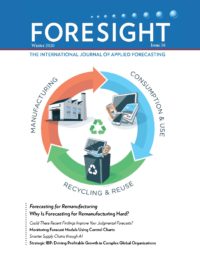Following is editor-in-chief Len Tashman's preview of the Winter 2020 issue of Foresight: The International Journal of Applied Forecasting.
Preview of Foresight (Winter 2020)
 This Winter 2020 issue of Foresight—number 56 since the journal began in 2005—formally introduces a new section: Integrated Business Planning (IBP), the meaning of which is evolving from a term virtually synonymous with Sales and Operations Planning (S&OP) to something far more encompassing, especially for large enterprises.
This Winter 2020 issue of Foresight—number 56 since the journal began in 2005—formally introduces a new section: Integrated Business Planning (IBP), the meaning of which is evolving from a term virtually synonymous with Sales and Operations Planning (S&OP) to something far more encompassing, especially for large enterprises.
For more than a generation, S&OP has provided the infrastructure through which forecasts are shared across functional areas of the company, then debated and hopefully reconciled. The emphasis has been short term, generally a planning horizon of several months, and tactical. Now, Foresight’s new Editor for IBP Dean Sorensen is proposing an expansive consideration of strategic as well as tactical elements. Dean’s article in the Forecasting and Planning Perspectives section of this issue sets the stage for a dialog on how fully integrated the planning function should be if the organization is to optimize its resources. This discussion helps forecasters to better understand the need for and use of their models and the time horizons that are important to the organization.
In his latest Hot New Research column, Paul Goodwin reports some surprising new results about the practice of judgmental forecasting.
A wealth of research papers has shown how judgment can act as a valuable complement to statistical models as long as organizational politics and psychological biases don’t lead the forecasts astray. Nevertheless, researchers continue to produce interesting and potentially useful findings—and some of these are surprising.
This issue also features an article on Forecasting for Remanufacturing by Thanos Goltsos and Aris Syntetos, the title referring to the transformation of used product components (cores) into essentially new products. This changes the planning tasks from “what to do at the end of product life to what to do at the end of each service life, as cores become inputs to the remanufacturing process.” This process also makes forecasting far more difficult, since not only must product demand be forecast but core returns as well, imposing what the authors call dual uncertainty. The key to forecasting returns is knowledge of the time-to-return distribution, the acquisition of which is significantly abetted by serialization, the linking of product sales to returns by time stamping through RFID and barcoding. Importantly, the authors demonstrate that traditional time-series procedures such as exponential smoothing “do not work well for returns forecasting, as they ignore the important relationship between returns and past sales.”
In his Commentary on the remanufacturing article, Ram Ganeshan expands on why forecasting in this “circular economy” is so complex and difficult to manage.
The use of process-control charts to monitor forecasting models is not new, but has typically required manual oversight. Now Joe Katz describes a near fully automated process that flags residuals for classification into severity zones. User rules then determine the action to be taken: Low Severity—No model changes required; Medium Severity—Adjust/refit existing model parameters; High Severity—Discard current model and develop new model.
Artificial Intelligence: The Hype and the Promise for Forecasting and Planning was the theme of Foresight’s practitioner conference November 13-14 in Chapel Hill, N.C. Forty-five people were in attendance to hear eight speakers and a panel cover a wide range of prospects for AI. Duncan Klett presented his views on the possibility of Smarter Supply Chains through AI, which we now offer to Foresight readers at large. Duncan sees a broad role for AI/ML in automating processes, validating data, segmenting items, and generating forecasts.
Mike Gilliland has assumed a new role as Foresight Associate Editor, where he will be reviewing a wide range of articles covering the practice of forecasting in organizations. Mike is Product Marketing Manager for SAS forecasting software and serves on the Board of Directors of the International Institute of Forecasters, publisher of this journal. He writes the blog “The Business Forecasting Deal,” authored the book The Business Forecasting Deal, was Principal Editor of Business Forecasting: Practical Problems and Solutions, and perhaps is best recognized for his development of the Forecast Value Added (FVA) metric that is so widely employed in industry.
On October 16, Chris Gray, Foresight Associate Editor, passed away unexpectedly. Chris’s death leaves a huge void in the fellowship of forecasters. Our recognition of his life’s work and some personal memories of Chris contributed by his friends follow on the next pages. We send our heartfelt condolences to Chris’s wife Leah and his extended family. We miss him.
